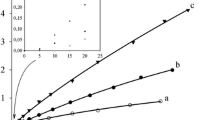Abstract
Upon further investigation of the recently reported electrocatalytic oxidation of 1,4-cyclohexadiene to benzene by Rh2(TM4) +24 (TM4=2,5-diisocyano-2,5-dimethylhexane), we have obtained data which strongly implicates the 2e− oxidized d7-d7 complex as the electroactive species. This contrasts with the original report which suggested that the le− oxidized d7-d8 radical acted as the key species via hydrogen atom abstraction from 1,4-cyclohexadiene. A possible mechanism for the catalysis is proposed.
Similar content being viewed by others
References
D.C. Smith and H.B. Gray, Catal. Lett. 6 (1990) 195.
K.R. Mann, J.A. Thich, R.A. Bell, G.G. Coyle and H.B. Gray, Inorg. Chem. 19 (1980) 2462.
M.G. Hill, W. Lamanna and K.R. Mann, Inorg. Chem. in press.
H. Nishida, N. Takade, M. Yoshimura, T. Sonoda and H. Kobayashi, Bull. Chem. Soc. Jpn. 57 (1984) 2600.
D.M. Roundhill, H.B. Gray and C.-M. Che, Ace. Chem. Res. 22 (1989) 55.
D.C. Smith and H.B. Gray, Coord. Chem. Rev. 100 (1990) 169.
A.E. Sherry and B.B. Wayland, J. Am. Chem. Soc. 112 (1990) 1259.
K. Garber, Ph.D. Thesis, University of Minnesota, 1988.
M.G. Hill and K.R. Mann, unpublished results
Attempts to generate solutions of Rh2(TM4)4(PF6) +22 from large-scale bulk electrolysis of [Rh2(TM4)4][PF6]2 in 0.1M TBA+PF }6 /CH2C12 resulted the considerable decomposition of the rhodium-containing species due to the instability of Rh2(TM4)4(PF6) +22 over long periods of time.
The cyclic voltammogram of Rh2(TM4) +24 in 0.1M TBA+C1O4 exhibits a quasi-reversible 2e− oxidation. At 25 °C, K′disp=18 [3]. Addition of 1,4-cyclohexadiene to this solution causes only a slight anodic current enhancement; however, exhaustive bulk electrolysis past the Rh2(TM4)4(ClO4) +22 /Rh2(TM4) +24 couple turns the catalysis over an average of 5 times.
Author information
Authors and Affiliations
Rights and permissions
About this article
Cite this article
Hill, M.G., Mann, K.R. The electroactive species in the catalysis of cyclohexadiene to benzene by Rh2(TM4) +24 (TM4=2,5-diisocyano-2,5-dimethylhexane). Catal Lett 11, 341–347 (1991). https://doi.org/10.1007/BF00764326
Received:
Accepted:
Issue Date:
DOI: https://doi.org/10.1007/BF00764326




